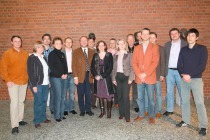Working group Rietveld established
The number of industrial and academic users of the quantitative phase analysis of cement according to Rietveld has been rapidly increased in the last few years. However, interlaboratory tests have shown that in part considerably diverging contents, especially for C3S/C2S and C3A, have been found in the individual working groups. On the one hand, this is due to different preparation techniques. On the other hand, software programs for the analytical method according to Rietveld permit different approaches as regards the refinement strategy. Thus, the results can only be compared up to a point.
...






